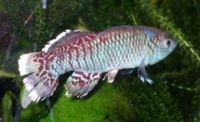Egger's Killifish (Nothobranchius eggersi)
From The Aquarium Wiki
Egger's Killifish
Nothobranchius eggersi
38 Litres (10 US G.)
3.8-5.1cm (1.5-2 ")
Freshwater
7.0 - 8.2
24 -28 °C (75.2-82.4°F)
10-25 °d
1:1 M:F
3-5 years
Family
Nothobranchiidae
This animal is available captive bred
Error creating thumbnail: Unable to save thumbnail to destination |
You can contribute to the Aquarium Wiki by expanding this article. Dont be shy!. |
Contents
Additional names
- Egger's Killifish, Egger's Nothobranch
Origin
|
|
This section requires expansion with: Location where this animal is found in the wild. |
Sexing
- Male's are more brightly coloured, also having a pattern. The colour and pattern vary depending on the collection location of the fish. Females are drab in appearance with little or no colour and no pattern.
Breeding
- These fish are bottom spawners. They lay their eggs into the substrate, because of this peat is often used as the substrate or is contained in tubs on the tank bottom. The parents spawn a few eggs during every embrace with embraces occurring fairly frequently. It is possible to get up to 100 eggs very quickly with the right diet. The peat must then be collected, dried to the consistency of pipe tobacco, and stored between 26-28°C (78.8-82.4°F) for some weeks. The amount of time required to store the eggs varies depending on a number of factors including age of fish and temperature. It is possible to tell when eggs are "ready" by viewing under a microscope. They should have a clearly visible eye which is surrounded by a gold ring. These eggs are referred to as "eyed-up" and are ready to be hatched. Once storing has been completed and the eyed-up eggs are ready, the peat is re-wet. After about 2 hours fry will begin to hatch. First foods should be very small i.e. rotifers and/or vinegar eels progressing after a few days onto baby brine shrimp. Growth rates are fast so ensure large amounts of food for the fry.
Tank compatibility
- This fish is normally kept in species aquarium, however fully grown specimens can be kept in peaceful community aquarium with little problems.
Diet
- They prefer a diet that consists mainly of live foods which is crucial not only to improve vitality of the fish but also increases the number of eggs produced. They will also take flake and pellet foods with some encouragement.
Feeding regime
- Feed these fish once or twice a day. They will feed from all levels of the aquarium usually allowing food to fall from the upper regions of the tank before taking it.
Environment Specifics
|
|
This section requires expansion with: Anything the species requires to be comfortable in the tank, such as caves or grasses. |
Behaviour
- Males will court the female fish for the majority of their time. Constantly chasing and showing off to the female to entice her to breed. Males can be aggressive to one another if confined to small aquariums but given enough space and enough females they will cause little or no harm to one another. Try to keep more females than males in any given tank. These fish will not attack other fish but can easily be picked on by larger more aggressive tank mates.
Identification
|
|
This section requires expansion with: Methods for identifying and differentiating this species from similar species. |
Pictures
External links
- Fishbase (Mirrors: Error creating thumbnail: Unable to save thumbnail to destination)
